Perles du Nord |
||||||||||||||||||||||
 |
 |
|||||||||||||||||||||
The set consists of: Knitted jumper with round yoke, multi-coloured Norwegian pattern and A-shape, worked top down. Sizes S - XXXL. Hat with multi-coloured Norwegian pattern. The set is worked in DROPS Flora.
DROPS 180-2 |
||||||||||||||||||||||
|
INFORMATION FOR THE PATTERN: DECREASE/INCREASE TIP: To work out how to decrease/increase evenly, count the total number of stitches on the needle (e.g. 120 stitches) and divide by the number of decreases/increases to be made (e.g. 18) = 6.6. In this example, decrease by knitting alternately every 5th and 6th stitch and every 6th and 7th stitch together. If you are increasing, do this after alternately every 6th and 7th stitch (increase 1 stitch by making 1 yarn over, on the next round, knit the yarn overs twisted and into the pattern so that there are no holes). ELEVATION: Insert 1 marker at the beginning of the round = mid back. Start from the right side with off white and knit until you have worked 8-8-9-10-10-11 stitches past the marker, turn, tighten the strand and purl 16-16-18-20-20-22 stitches. Turn, tighten the strand and knit 24-24-27-30-30-33 stitches, turn, tighten the strand and purl 32-32-36-40-40-44 stitches. Turn, tighten the strand and knit 40-40-45-50-50-55 stitches, turn, tighten the strand and purl 48-48-54-60-60-66 stitches. Turn, tighten the strand and knit 56-56-63-70-70-77 stitches, turn, tighten the strand and purl 64-64-72-80-80-88 stitches. Turn, tighten the strand and knit to mid back. PATTERN: Jumper: See diagrams A.1 to A.3. Choose diagram for your size. Hat: See diagrams A.4 and A.5. The diagrams show all the rows in the pattern seen from the right side. The whole of the pattern is worked in stocking stitch. KNITTING TIP (for the multi-coloured pattern): To prevent the knitting tension from becoming tighter when working pattern, it is important that the strands do not tighten at the back of the piece. You can increase the size of your needle when working pattern if you find you are working too tightly. INCREASE TIP (for the sides of the body): Start 2 stitches before the marker thread, make 1 yarn over, knit 4 (the marker thread sits in the middle of these 4 stitches), make 1 yarn over (= 2 stitches increased). On the next round knit the yarn overs twisted so that there are no holes. DECREASE TIP-1 (for mid under the sleeve): Work until there are 4 stitches left before the marker thread, knit 2 together, knit 4 (the marker thread sits in the middle of these 4 stitches), slip 1 stitch as if to knit, knit 1, pass the slipped stitch over the knitted stitch (= 2 stitches decreased). DECREASE TIP-2 (for the hat): Decrease after each marker thread as follows: Slip 1 stitch as if to knit, knit 1, pass the slipped stitch over the knitted stitch (= 1 stitch decreased). ---------------------------------------------------------- JUMPER: The piece is worked in the round with circular needle, top down. The sleeve is worked in the round with short circular needle, top down. Change to double pointed needles when you have decreased enough stitches. NECKLINE: Cast on 120-124-128-132-140-148 stitches with circular needle size 2.5 mm and off white. Knit 1 round. Then work rib (= knit 2 / purl 2). When the rib measures 3 cm, knit 1 round where you decrease 18-16-14-12-14-16 stitches evenly on round – read DECREASE/INCREASE TIP = 102-108-114-120-126-132 stitches. Continue to work the yoke as described below. YOKE: Change to circular needle size 3 mm. Knit 1 round. For a better fit you can now work a small ELEVATION in the back of the neck – see description above. When the elevation is complete, work A.1 in the round (= 17-18-19-20-21-22 repeats of 6 stitches). Continue the pattern in this way and increase as shown in the diagram. Read KNITTING TIP and REMEMBER THE KNITTING TENSION! On the round marked with a star in A.1 (i.e. the next to last round in A.1) there are 221-234-247-260-315-330 stitches on the needle, increase at the same time 11-22-33-36-21-22 stitches evenly on this round – read DECREASE/INCREASE TIP = 232-256-280-296-336-352 stitches. When A.1 is complete, work A.2 in the round (= 29-32-35-37-42-44 repeats of 8 stitches). Continue the pattern in this way, but on the round marked with a star in A.2 (i.e. the next to last round in A.2) increase 8-16-24-24-16-16 stitches evenly on round = 240-272-304-320-352-368 stitches. When A.2 is complete, work A.3 in the round (= 15-17-19-20-22-23 repeats of 16 stitches). Continue the pattern in this way and increase as shown in the diagram. When the last round in A.3 remains (marked with an arrow in each size) there are 315-357-399-420-462-483 stitches on the needle, increase at the same time 11-11-1-12-0-5 stitches evenly on the round = 326-368-400-432-462-488 stitches. The piece now measures approx. 24-26-28-30-32-34 cm from the cast-on edge, measured mid front. NOTE: If the piece measures less than this, continue working stocking stitch with green to the required length. The next round is worked as follows: Knit 50-55-59-65-71-76 stitches (= ½ back piece), place the next 64-75-83-86-90-93 stitches on a thread for sleeve, cast on 10-10-12-12-14-16 new stitches on the needle (= in the side under the sleeve), knit 99-109-117-130-141-151 stitches (= front piece), place the next 64-75-83-86-90-93 stitches on a thread for sleeve, cast on 10-10-12-12-14-16 new stitches on the needle (= in the side under the sleeve) and knit the remaining 49-54-58-65-70-75 stitches (= ½ back piece). Cut the strand. Body and sleeves are finished separately. THE PIECE IS NOW MEASURED FROM HERE! BODY: = 218-238-258-284-310-334 stitches. Insert 1 marker thread in the middle of the 10-10-12-12-14-16 stitches cast on under the sleeve in each side. Start the round by one of the marker threads and work stocking stitch in the round with green. When the piece measures 2 cm from the division, increase 1 stitch on each side of both marker threads – read INCREASE TIP (= 4 stitches increased). Increase in this way every 10th round (approx. every 3 cm) until required length (if the knitting tension is correct in height, there should be approx. 9 increase rows in each side). When the piece measures 30 cm from the division in all sizes, there are approx 254-274-294-320-346-370 stitches on the needle. Knit 1 round where you increase 82-90-98-104-114-122 stitches evenly on round – read DECREASE/INCREASE TIP = 336-364-392-424-460-492 stitches. Change to circular needle size 2.5 mm and work rib in the round (= knit 2 / purl 2) for 4 cm. Then cast off with knit over knit and purl over purl, but to prevent the cast-off edge being tight, you can make 1 yarn over on the needle after every 4th stitch AT THE SAME TIME as you cast off (the yarn overs are cast off as normal stitches). The jumper measures approx. 58-60-62-64-66-68 cm from the shoulder down. SLEEVE: Place the 64-75-83-86-90-93 stitches from the thread on one side of the piece on a short circular needle size 3 mm and in addition, knit up 1 stitch in each of the 10-10-12-12-14-16 stitches cast on under the sleeve = 74-85-95-98-104-109 stitches on the needle. Insert 1 marker thread in the middle of the 10-10-12-12-14-16 stitches under the sleeve. Start the round here and work stocking stitch in the round with green. When the sleeve measures 2 cm from the division, decrease 2 stitches mid under the sleeve – read DECREASE TIP. Decrease a total of 11-15-19-19-21-22 times in S: Every 9th round, in M: Every 6th round, in L and XL: Every 4th round, in XXL: Alternately every 3rd and 4th round and in XXXL: Every 3rd round = 52-55-57-60-62-65 stitches. When the sleeve measures 31-29-28-26-25-23 cm from the division (shorter measurements in the larger sizes due to longer yoke), knit 1 round where you increase 16-17-19-20-18-19 stitches evenly on round = 68-72-76-80-80-84 stitches. Change to double pointed needles size 2.5 mm and work rib in the round (= knit 2 / purl 2). When the rib measures 10 cm (or desired length) cast off with knit over knit and purl over purl, but to prevent the cast-off edge being tight, you can make 1 yarn over after every 4th stitch AT THE SAME TIME as you cast off (the yarn overs are cast off as normal stitches). The sleeve measures approx. 41-39-38-36-35-33 cm from the division. Work the second sleeve in the same way. ---------------------------------------------------------- HAT: The piece is worked in the round with short circular needle, bottom up. Change to double pointed needles as the number of stitches decreases. Cast on 128-136 stitches with circular needle size 2.5 mm and off white. Knit 1 round. Then work rib (= knit 2 / purl 2) for 4 cm. Change to short circular needle size 3 mm and knit 2 rounds – AT THE SAME TIME on the first round, increase 4-8 stitches evenly on round – read DECREASE/INCREASE TIP = 132-144 stitches. Work A.4 in the round (= 11-12 repeats of 12 stitches). On the last round in A.4 (marked with a star in the diagram), decrease 4-8 stitches evenly on round = 128-136 stitches. REMEMBER THE KNITTING TENSION! Now work A.5 in the round (= 16-17 repeats of 8 stitches). On the next to last round in A.5 (marked with a star in the diagram), decrease 8-4 stitches evenly on round = 120-132 stitches. The piece now measures approx. 16 cm in height. Continue working stocking stitch with green until the piece measures 20-23 cm. Insert 10-11 marker threads in the piece with 12 stitches between each marker thread. On the next round, decrease 1 stitch after each marker thread – read DECREASE TIP (= 10-11 stitches decreased). Decrease in this way every 2nd round a total of 8 times and then every round a total of 2 times = 20-22 stitches. On the next round knit all stitches together, 2 and 2 = 10-11 stitches. Cut the strand, pull it through the remaining stitches, tighten the strand and fasten well. The hat measures approx. 25-28 cm top down. |
||||||||||||||||||||||
Diagram explanations |
||||||||||||||||||||||
|
||||||||||||||||||||||

|
||||||||||||||||||||||
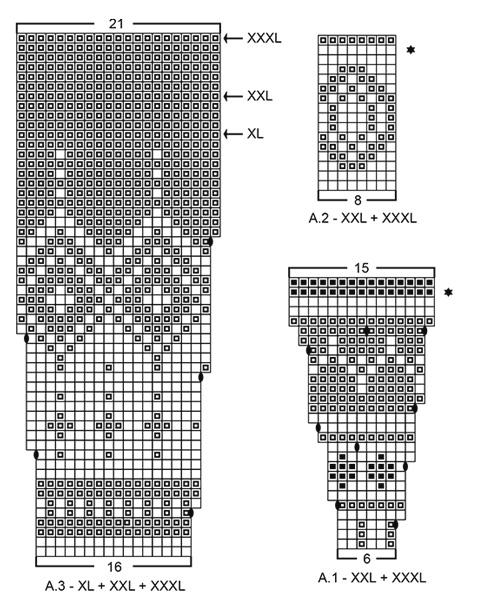
|
||||||||||||||||||||||

|
||||||||||||||||||||||
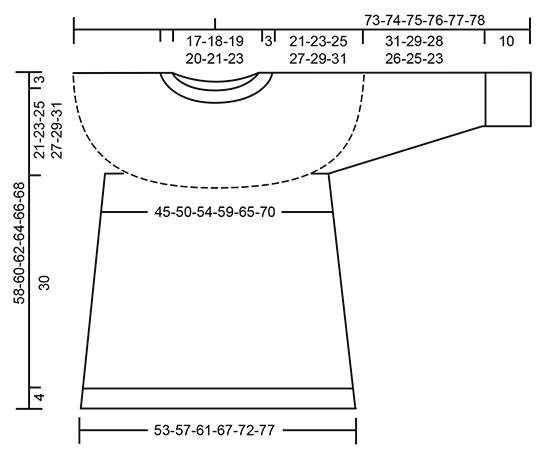
|
||||||||||||||||||||||
|
Have you made this or any other of our designs? Tag your pictures in social media with #dropsdesign so we can see them! Do you need help with this pattern?You'll find tutorial videos, a Comments/Questions area and more by visiting the pattern on garnstudio.com. © 1982-2024 DROPS Design A/S. We reserve all rights. This document, including all its sub-sections, has copyrights. Read more about what you can do with our patterns at the bottom of each pattern on our site. |
||||||||||||||||||||||








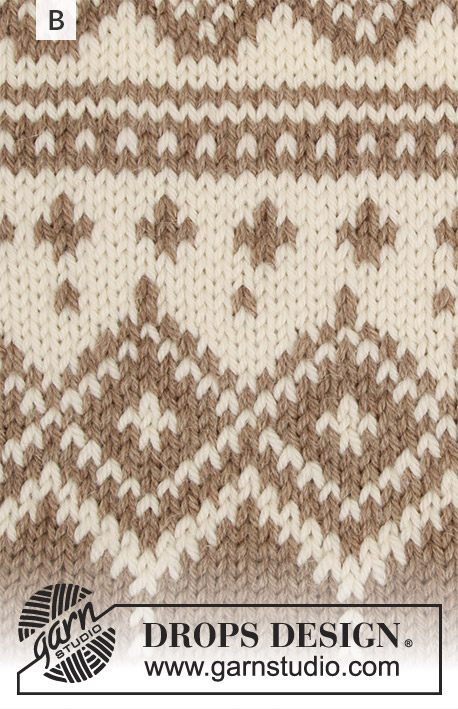




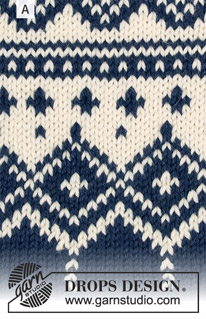
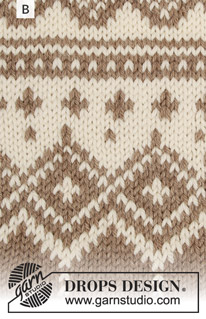



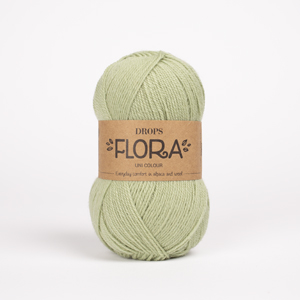
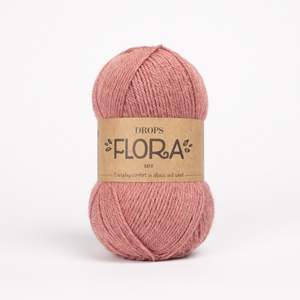


























































Comments / Questions (106)
Buongiorno ho terminato lo sprone e sto proseguendo con il corpo, usando il filato consigliato, con tensione giusta, corrispondono infatti i cm con i giri su cui fare gli aumenti, tuttavia la lunghezza del maglione dalla divisione all'inizio delle coste in basso risulta parecchio corto. Penso che proseguiro' ancora qualche cm in lunghezza.
26.12.2020 - 11:33Merci pour votre réponse rapide.En effet ,j'avais fait une erreur sur le 11 ème rang,je faisais 4 mailles blanches,1 verte , 4 blanches, 1 verte,etc.....je n'avais pas remarqué qu'il y avait 3 petits motifs et une simple maille,je faisais sur tout le rang 14 3 mailles vertes ,2 blanches. merci pour votre éclairage qui m'a remise sur le droit chemin !....... Anne-marie Naudin
23.12.2020 - 15:42Je fais le modèle 180-2, top down jacquard en rond.TailleXXXL.Si je fais le jeté (augm) du rang 11 du motif A.3,le motif ligne13 est complètement décalé, et je suis inquiète pour les augm.des lignes 19 et 23.Il n'y a pas eu de problèmes pour les motifs A1 et A2 parce que les augm.étaient prévues avant des rangs unis sans motifs....Comment faire s'il vous plait ?
14.12.2020 - 00:41DROPS Design answered:
Bonjour Mme Naudin, le 2ème jeté de A.3 (= rang 11ème rang) ne doit pas tout décaler, vous devez tricoter cette maille en blanc au tour suivant, puis, répéter le tour 13 (pas le motif) autrement dit le tour 13 va être *4 m blanc, 1 m vert, 4 m blanc, 1 m vert, 4 m blanc, 1 m env, 3 m blanc*, répétez de *-* = vous aurez 7 m blanc entre les diagrammes, c'est normal. de même à l'augmentation suivante, c'est le jeté = l'augmentation du début du tour qui sera tricotée en vert au tour suivant. Rien ne doit être décalé mais se présenter comme dans le diagramme. Bon tricot!
14.12.2020 - 09:50Ærmerne bliver meget smalle. Jeg undlod indtagning. før jeg nåede til ribben. Det blev så flot.
07.12.2020 - 11:07Er det riktig at det skal legges ut 104 masker før vrangborden? Strikker str xl
03.08.2020 - 19:54DROPS Design answered:
Hej Eva, ja for du strikker vrangborden på pind 2,5 og i rib, så hver maske bliver mindre end dem du tidligere har strikket. God fornøjelse!
04.08.2020 - 10:07Har strikket ferdig, men er skuffet over halsen. Den er ikke i tråd med bildet, men mye smalere, og høyere opp på på halsen. På bildet er den avbildet bredere og lenger ned på halsen. Jeg ser i oppskriften på jakken i samme mønster, så har halsen mange flere masker ( også når vi ser bort fra stolpemaskene Der skal også halsmaskene økes, på genseroppskriften skal de felles. Er det en feil i antall maske.? Jeg syens den blir for høy og smal - da blir genseren veldig varm og tett
18.07.2020 - 22:10DROPS Design answered:
Hej Ane, efter de 3 cm rib, så justeres maskerne og så er der kun nogle få masker til forskel og de skal bruges i stolpemaskerne. De stemmer også med målene i måleskitsen nederst, så opskriften stemmer. Men hvorfor ikke strikke halskanten om så du får den som du vil have den. God fornøjelse!
31.07.2020 - 09:11Hej jeg vil rigtig gerne strikke denne trøje, men jeg er en str. XS kan jeg få hjælp til at "koge opskriften ned" til en XS :-) venlig hilsen Birthe Frandsen
02.07.2020 - 10:24DROPS Design answered:
Hej Birthe, vi har desværre ikke mulighed for at skrive opskriften om til en anden størrelse. Men da blusen strikkes ovenfra og ned, så kan du måske stoppe udtagningerne i bærestykket lidt tidligere... Hvis du sætter maskerne på flere rundpinde, så kan du prøve blusen og se hvornår du har nok masker. God fornøjelse!
02.07.2020 - 10:46Ksn ikke finde ud af ! Hvilke af diagrammerne skal jeg bruge, når jeg skal strikke sweateren i str. XXL
06.06.2020 - 07:08Impossible d'enregistrer le pdf. J'ai la veste, mais pas le pull. Pourriez-vous regarder, s'il vous plait ? Merci d'avance.
08.05.2020 - 04:21DROPS Design answered:
Bonjour Mme Leb, cliquez sur l'icône pour imprimer le modèle et choisissez alors une imprimante virtuelle pour enregistrer les explications en format .pdf. Bon tricot!
08.05.2020 - 09:18Comment respecter la régularité du motif lorsque l'on doit faire des augmentations dedans ?
23.04.2020 - 09:29DROPS Design answered:
Bonjour Mme Desruol, les augmentations de l'empiècement sont comprises dans les diagrammes (A.1 et A.3 = jetés), il vous suffit simplement de faire ces jetés aux endroits indiqués du diagramme et de les tricoter au rang suivant de la couleur indiquée. Bon tricot!
23.04.2020 - 10:04